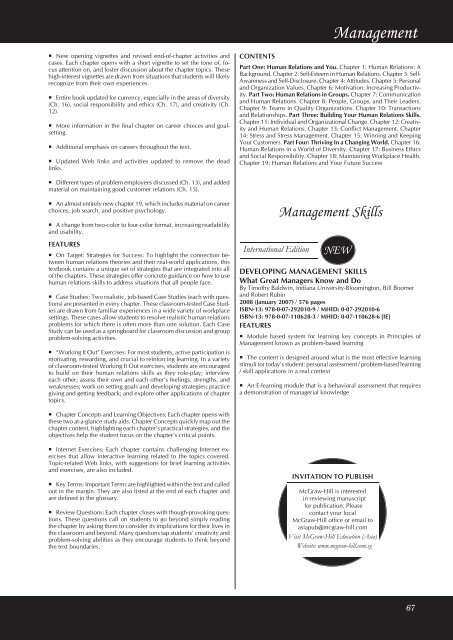Business Communication - McGraw-Hill Books
Business Communication - McGraw-Hill Books
Business Communication - McGraw-Hill Books
You also want an ePaper? Increase the reach of your titles
YUMPU automatically turns print PDFs into web optimized ePapers that Google loves.
Management• New opening vignettes and revised end-of-chapter activities andcases. Each chapter opens with a short vignette to set the tone of, focusattention on, and foster discussion about the chapter topics. Thesehigh-interest vignettes are drawn from situations that students will likelyrecognize from their own experiences.• Entire book updated for currency, especially in the areas of diversity(Ch. 16), social responsibility and ethics (Ch. 17), and creativity (Ch.12).• More information in the final chapter on career choices and goalsetting.• Additional emphasis on careers throughout the text.• Updated Web links and activities updated to remove the deadlinks.CONTENTSPart One: Human Relations and You. Chapter 1: Human Relations: ABackground. Chapter 2: Self-Esteem in Human Relations. Chapter 3: Self-Awareness and Self-Disclosure. Chapter 4: Attitudes. Chapter 5: Personaland Organization Values. Chapter 6: Motivation: Increasing Productivity.Part Two: Human Relations in Groups. Chapter 7: <strong>Communication</strong>and Human Relations. Chapter 8: People, Groups, and Their Leaders.Chapter 9: Teams in Quality Organizations. Chapter 10: Transactionsand Relationships. Part Three: Building Your Human Relations Skills.Chapter 11: Individual and Organizational Change. Chapter 12: Creativityand Human Relations. Chapter 13: Conflict Management. Chapter14: Stress and Stress Management. Chapter 15: Winning and KeepingYour Customers. Part Four: Thriving In a Changing World. Chapter 16:Human Relations in a World of Diversity. Chapter 17: <strong>Business</strong> Ethicsand Social Responsibility. Chapter 18: Maintaining Workplace Health.Chapter 19: Human Relations and Your Future Success• Different types of problem employees discussed (Ch. 13), and addedmaterial on maintaining good customer relations (Ch. 15).• An almost entirely new chapter 19, which includes material on careerchoices, job search, and positive psychology.• A change from two-color to four-color format, increasing readabilityand usability.FEATURES• On Target: Strategies for Success: To highlight the connection betweenhuman relations theories and their real-world applications, thistextbook contains a unique set of strategies that are integrated into allof the chapters. These strategies offer concrete guidance on how to usehuman relations skills to address situations that all people face.• Case Studies: Two realistic, job-based Case Studies (each with questions)are presented in every chapter. These classroom-tested Case Studiesare drawn from familiar experiences in a wide variety of workplacesettings. These cases allow students to resolve realistic human relationsproblems for which there is often more than one solution. Each CaseStudy can be used as a springboard for classroom discussion and groupproblem-solving activities.• “Working It Out” Exercises: For most students, active participation ismotivating, rewarding, and crucial to reinforcing learning. In a varietyof classroom-tested Working It Out exercises, students are encouragedto build on their human relations skills as they role-play; intervieweach other; assess their own and each other’s feelings, strengths, andweaknesses; work on setting goals and developing strategies; practicegiving and getting feedback; and explore other applications of chaptertopics.International EditionManagement SkillsNEWDEVELOPING MANAGEMENT SKILLSWhat Great Managers Know and DoBy Timothy Baldwin, Indiana University-Bloomington, Bill Boomerand Robert Rubin2008 (January 2007) / 576 pagesISBN-13: 978-0-07-292010-9 / MHID: 0-07-292010-6ISBN-13: 978-0-07-110628-3 / MHID: 0-07-110628-6 [IE]FEATURES• Module based system for learning key concepts in Principles ofManagement known as problem-based learning• The content is designed around what is the most effective learningstimuli for today’s student: personal assessment / problem-based learning/ skill applications in a real context• An E-learning module that is a behavioral assessment that requiresa demonstration of managerial knowledge• Chapter Concepts and Learning Objectives: Each chapter opens withthese two at-a-glance study aids. Chapter Concepts quickly map out thechapter content, highlighting each chapter’s practical strategies, and theobjectives help the student focus on the chapter’s critical points.• Internet Exercises: Each chapter contains challenging Internet exercisesthat allow interactive learning related to the topics covered.Topic-related Web links, with suggestions for brief learning activitiesand exercises, are also included.• Key Terms: Important Terms are highlighted within the text and calledout in the margin. They are also listed at the end of each chapter andare defined in the glossary.• Review Questions: Each chapter closes with though-provoking questions.These questions call on students to go beyond simply readingthe chapter by asking them to consider its implications for their lives inthe classroom and beyond. Many questions tap students’ creativity andproblem-solving abilities as they encourage students to think beyondthe text boundaries.INVITATION TO PUBLISH<strong>McGraw</strong>-<strong>Hill</strong> is interestedin reviewing manuscriptfor publication. Pleasecontact your local<strong>McGraw</strong>-<strong>Hill</strong> office or email toasiapub@mcgraw-hill.comVisit <strong>McGraw</strong>-<strong>Hill</strong> Education (Asia)Website: www.mcgraw-hill.com.sg67HED 2007 Management.indd 6710/5/2006 1:24:17 PM

















